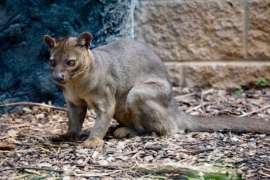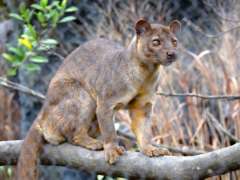Fossa
Fossa
Fossas are the largest carnivores on the island of Madagascar, where they feed on a varieties of mammals, including lemurs. They typically hunt and live alone. Like most species on Madagascar, fossas are threatened by habitat loss.
Cryptoprocta ferox
Carnivore
Madagascar [VIEW MAP]
Rainforests
Like many carnivores, fossa sleep for many hours of each day, so our fossa is often seen napping. Check the shady spots on warmer days and the sunny patches on cooler days.
Photos and Videos
While they resemble cats, fossas actually belong to the Family Eupleridae, a group of carnivores found only on Madagascar. The fossa’s tail makes up about half of its overall length, which can be up to 6 feet. Females weigh between 11 and 15 pounds, and males weigh between 13 and 22 pounds. Fossas are usually entirely nocturnal in the vicinity of human settlements, possibly as a result of hunting and competition with domestic dogs. They are hunted by humans for food and to eliminate predation on livestock.
Fossas can have a total body length of 6 feet, including the tail. The tail is long, sometimes exceeding 30 inches in length, and can make up about half of the total length of the animal.
With their bulbous noses and pronounced whiskers, their face may resemble an otter, but the overall impression one gets from these animals is their resemblance to cats. Like some cats the fossa has semi-retractable claws and a reduced number of specialized tissue-shearing teeth. Fossas are expert climbers. Their flexible ankle joints along with their large, hairless footpads allow them to get a better grip on branches, with their long tail also acting as a balance organ.
Fossas are generally solitary, except for the breeding season. Males and females will occupy territories defined by scent marking. Females will mew to attract males, and the males will howl and yowl while competing for the female.
Fossas have an unusual mating system. A female will occupy a tree, and males will congregate below. The males will fight and call to the female. Over a one-week period, the female will mate with up to six different males. Once this is done, a new female will arrive, replacing the first female and mating with the gathered males.
The mating season occurs from September to November. Gestation lasts approximately three months, with two to four pups born per litter. The pups are born blind and helpless and will open their eyes after 15 days. The young remain in the den until they are 4 to 5 months old and will stay with their mothers until they are 15 to 20 months old.
Like many carnivores, fossa sleep for many hours of each day, so our fossa is often seen napping. Check the shady spots on warmer days and the sunny patches on cooler days.
Madagascar
Fossas are usually associated with undisturbed rainforests, usually at low densities.
The fossa is entirely carnivorous, feeding on various small mammals, birds and reptiles. At the Zoo, the fossa is offered ground beef made from almost the entire beef carcass, as well as frozen/thawed mice, rabbits and chickens.
Our fossa, Logan, has an enclosure including trees and ropes, allowing him to climb freely as he would in the wild. Food and treats also are offered in a variety of ways, including surprise-treat balls.



